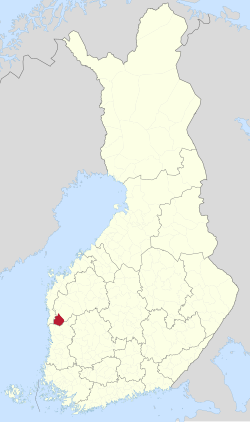You can help expand this article with text translated from the corresponding article in Finnish. (June 2023) Click [show] for important translation instructions.
|
Isojoki
Storå | |
|---|---|
Municipality | |
| Isojoen kunta Storå kommun | |
 Isojoki church and bell tower | |
 Location of Isojoki in Finland | |
| Coordinates: 62°06′50″N 21°57′30″E / 62.11389°N 21.95833°E | |
| Country | |
| Region | South Ostrobothnia |
| Sub-region | Suupohja sub-region |
| Charter | 1855 |
| Government | |
| • Municipal manager | Juha Herrala |
| Area (2018-01-01)[1] | |
• Total | 647.43 km2 (249.97 sq mi) |
| • Land | 642.4 km2 (248.0 sq mi) |
| • Water | 5.05 km2 (1.95 sq mi) |
| • Rank | 134th largest in Finland |
| Population (2024-10-31)[2] | |
• Total | 1,798 |
| • Rank | 265th largest in Finland |
| • Density | 2.8/km2 (7/sq mi) |
| Population by native language | |
| • Finnish | 94.8% (official) |
| • Swedish | 0.8% |
| • Others | 4.4% |
| Population by age | |
| • 0 to 14 | 11.3% |
| • 15 to 64 | 55.1% |
| • 65 or older | 33.7% |
| Time zone | UTC+02:00 (EET) |
| • Summer (DST) | UTC+03:00 (EEST) |
| Website | www.isojoki.fi |
Isojoki (Swedish: Storå; lit. "Big River") is a municipality of Finland. It is part of the South Ostrobothnia region. The city of Pori is located 83 kilometres (52 mi) south of Isojoki. Neighbouring municipalities are Honkajoki, Karijoki, Kauhajoki, Kristinestad, Merikarvia and Siikainen. The population of Isojoki is 1,798 (31 October 2024).[2] The municipality covers an area of 642.4 km2 (248.0 sq mi), of which 5.05 km2 (1.95 sq mi) is inland water (1 January 2018).[1] The population density is 2.8/km2 (7.3/sq mi). The municipality is unilingually Finnish.
Although the area is not very high, one of the highest hills of southern Finland is located here (Lauhanvuori). Many Finns from this area have emigrated to Minnesota, in the USA, as well as Michigan.[citation needed]
Industry: wood, potato, machinery
Tourism: Lauhanvuori National Park (hotel, viewtower, big smoke sauna, historical nature with many relics from ice-age)
Nature: Mostly Forest, swamp and agriculture
- ^ a b "Area of Finnish Municipalities 1.1.2018" (PDF). National Land Survey of Finland. Retrieved 30 January 2018.
- ^ a b c "Finland's preliminary population figure was 5,635,560 at the end of October 2024". Population structure. Statistics Finland. 19 November 2024. ISSN 1797-5395. Retrieved 22 November 2024.
- ^ "Population according to age (1-year) and sex by area and the regional division of each statistical reference year, 2003–2020". StatFin. Statistics Finland. Retrieved 2 May 2021.
- ^ a b "Luettelo kuntien ja seurakuntien tuloveroprosenteista vuonna 2023". Tax Administration of Finland. 14 November 2022. Retrieved 7 May 2023.
